Scottish vs Croatian Community Comparison
COMPARE
Scottish
Croatian
Social Comparison
Social Comparison
Scottish
Croatians
6,834
SOCIAL INDEX
65.8/ 100
SOCIAL RATING
139th/ 347
SOCIAL RANK
8,930
SOCIAL INDEX
86.8/ 100
SOCIAL RATING
37th/ 347
SOCIAL RANK
Croatian Integration in Scottish Communities
The statistical analysis conducted on geographies consisting of 374,127,975 people shows a significant positive correlation between the proportion of Croatians within Scottish communities in the United States with a correlation coefficient (R) of 0.670. On average, for every 1% (one percent) increase in Scottish within a typical geography, there is an increase of 0.217% in Croatians. To illustrate, in a geography comprising of 100,000 individuals, a rise of 1,000 Scottish corresponds to an increase of 217.4 Croatians.
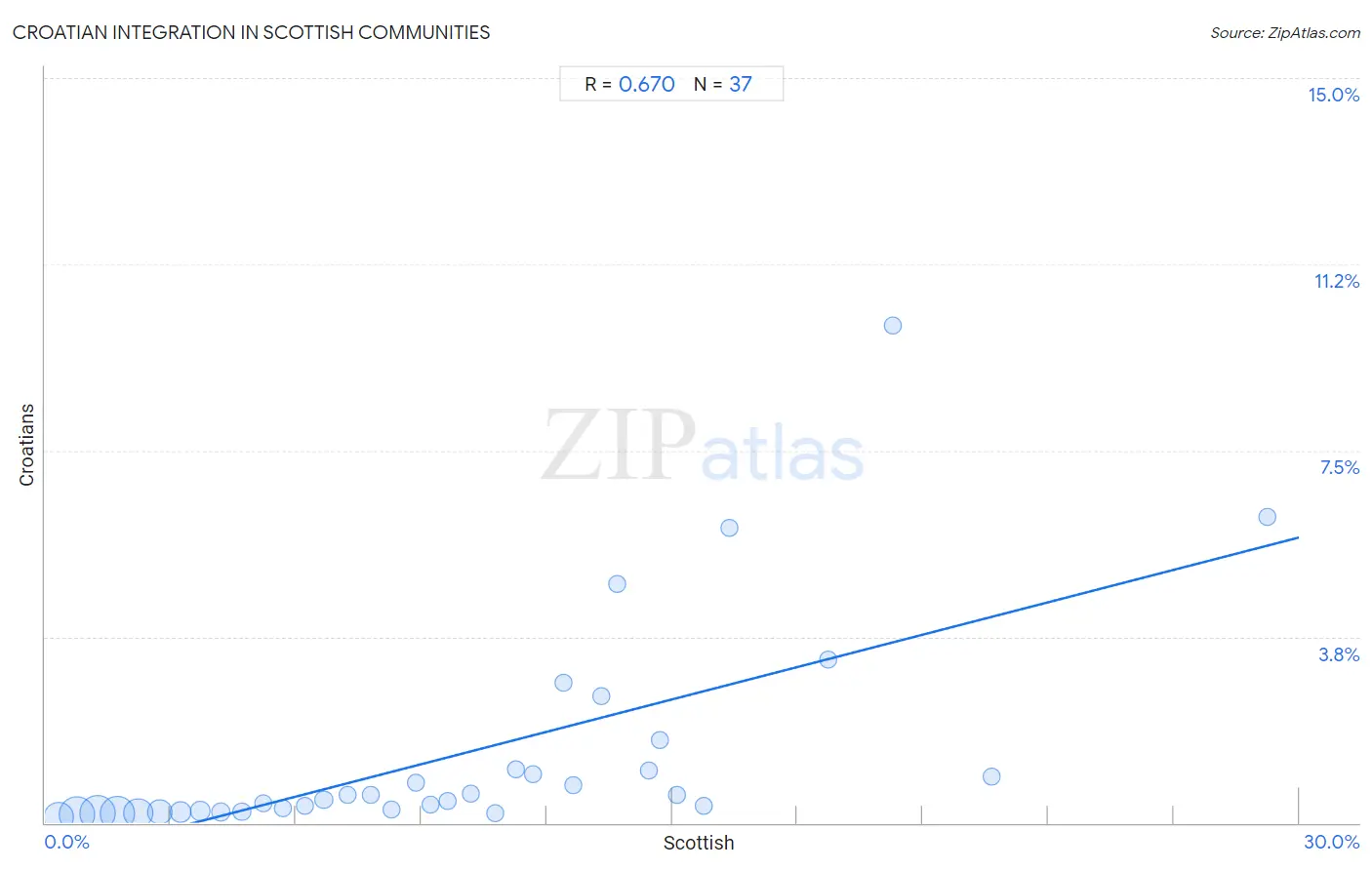
Scottish vs Croatian Income
When considering income, the most significant differences between Scottish and Croatian communities in the United States are seen in householder income ages 25 - 44 years ($94,622 compared to $102,414, a difference of 8.2%), per capita income ($44,440 compared to $47,742, a difference of 7.4%), and median male earnings ($55,793 compared to $59,715, a difference of 7.0%). Conversely, both communities are more comparable in terms of wage/income gap (29.1% compared to 29.0%, a difference of 0.51%), householder income under 25 years ($50,554 compared to $51,662, a difference of 2.2%), and householder income over 65 years ($61,735 compared to $63,225, a difference of 2.4%).

| Income Metric | Scottish | Croatian |
| Per Capita Income | Good $44,440 | Exceptional $47,742 |
| Median Family Income | Good $104,288 | Exceptional $111,370 |
| Median Household Income | Average $85,101 | Exceptional $90,685 |
| Median Earnings | Average $46,463 | Exceptional $49,724 |
| Median Male Earnings | Good $55,793 | Exceptional $59,715 |
| Median Female Earnings | Tragic $38,397 | Exceptional $40,993 |
| Householder Age | Under 25 years | Tragic $50,554 | Fair $51,662 |
| Householder Age | 25 - 44 years | Average $94,622 | Exceptional $102,414 |
| Householder Age | 45 - 64 years | Good $102,123 | Exceptional $108,383 |
| Householder Age | Over 65 years | Good $61,735 | Exceptional $63,225 |
| Wage/Income Gap | Tragic 29.1% | Tragic 29.0% |
Scottish vs Croatian Poverty
When considering poverty, the most significant differences between Scottish and Croatian communities in the United States are seen in female poverty among 25-34 year olds (13.9% compared to 12.5%, a difference of 10.9%), single female poverty (21.8% compared to 19.7%, a difference of 10.7%), and female poverty among 18-24 year olds (20.9% compared to 19.0%, a difference of 10.0%). Conversely, both communities are more comparable in terms of seniors poverty over the age of 75 (10.5% compared to 10.5%, a difference of 0.15%), seniors poverty over the age of 65 (9.2% compared to 9.1%, a difference of 0.58%), and receiving food stamps (9.9% compared to 9.6%, a difference of 2.9%).
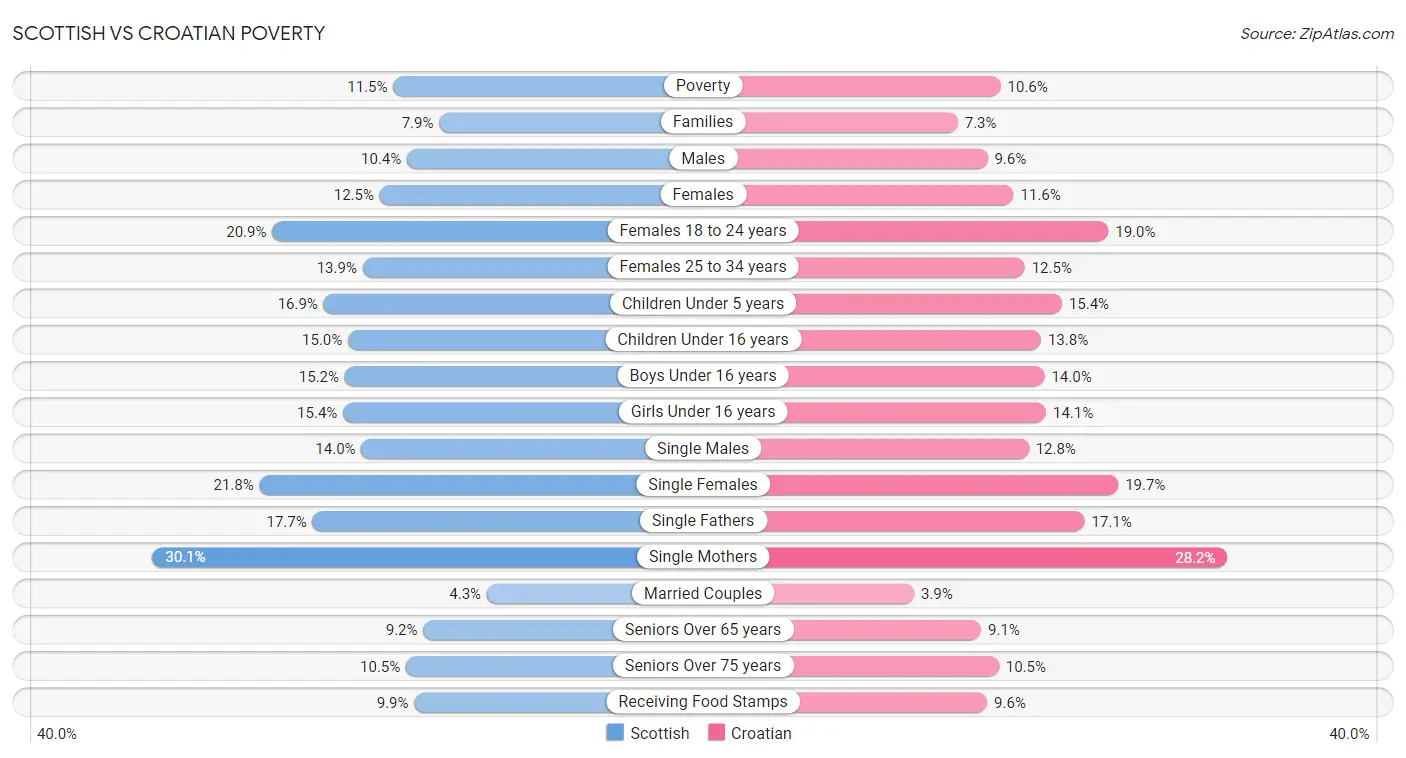
| Poverty Metric | Scottish | Croatian |
| Poverty | Exceptional 11.5% | Exceptional 10.6% |
| Families | Exceptional 7.9% | Exceptional 7.3% |
| Males | Exceptional 10.4% | Exceptional 9.6% |
| Females | Exceptional 12.5% | Exceptional 11.6% |
| Females 18 to 24 years | Tragic 20.9% | Exceptional 19.0% |
| Females 25 to 34 years | Fair 13.9% | Exceptional 12.5% |
| Children Under 5 years | Good 16.9% | Exceptional 15.4% |
| Children Under 16 years | Exceptional 15.0% | Exceptional 13.8% |
| Boys Under 16 years | Exceptional 15.2% | Exceptional 14.0% |
| Girls Under 16 years | Exceptional 15.4% | Exceptional 14.1% |
| Single Males | Tragic 14.0% | Average 12.8% |
| Single Females | Tragic 21.8% | Exceptional 19.7% |
| Single Fathers | Tragic 17.7% | Tragic 17.1% |
| Single Mothers | Tragic 30.1% | Exceptional 28.2% |
| Married Couples | Exceptional 4.3% | Exceptional 3.9% |
| Seniors Over 65 years | Exceptional 9.2% | Exceptional 9.1% |
| Seniors Over 75 years | Exceptional 10.5% | Exceptional 10.5% |
| Receiving Food Stamps | Exceptional 9.9% | Exceptional 9.6% |
Scottish vs Croatian Unemployment
When considering unemployment, the most significant differences between Scottish and Croatian communities in the United States are seen in unemployment among women with children ages 6 to 17 years (9.4% compared to 8.8%, a difference of 5.7%), unemployment among seniors over 75 years (10.1% compared to 9.6%, a difference of 5.3%), and unemployment among women with children under 6 years (7.9% compared to 7.5%, a difference of 5.0%). Conversely, both communities are more comparable in terms of unemployment among youth under 25 years (10.9% compared to 10.9%, a difference of 0.10%), unemployment among ages 16 to 19 years (16.2% compared to 16.3%, a difference of 0.24%), and unemployment among seniors over 65 years (4.9% compared to 4.9%, a difference of 0.24%).
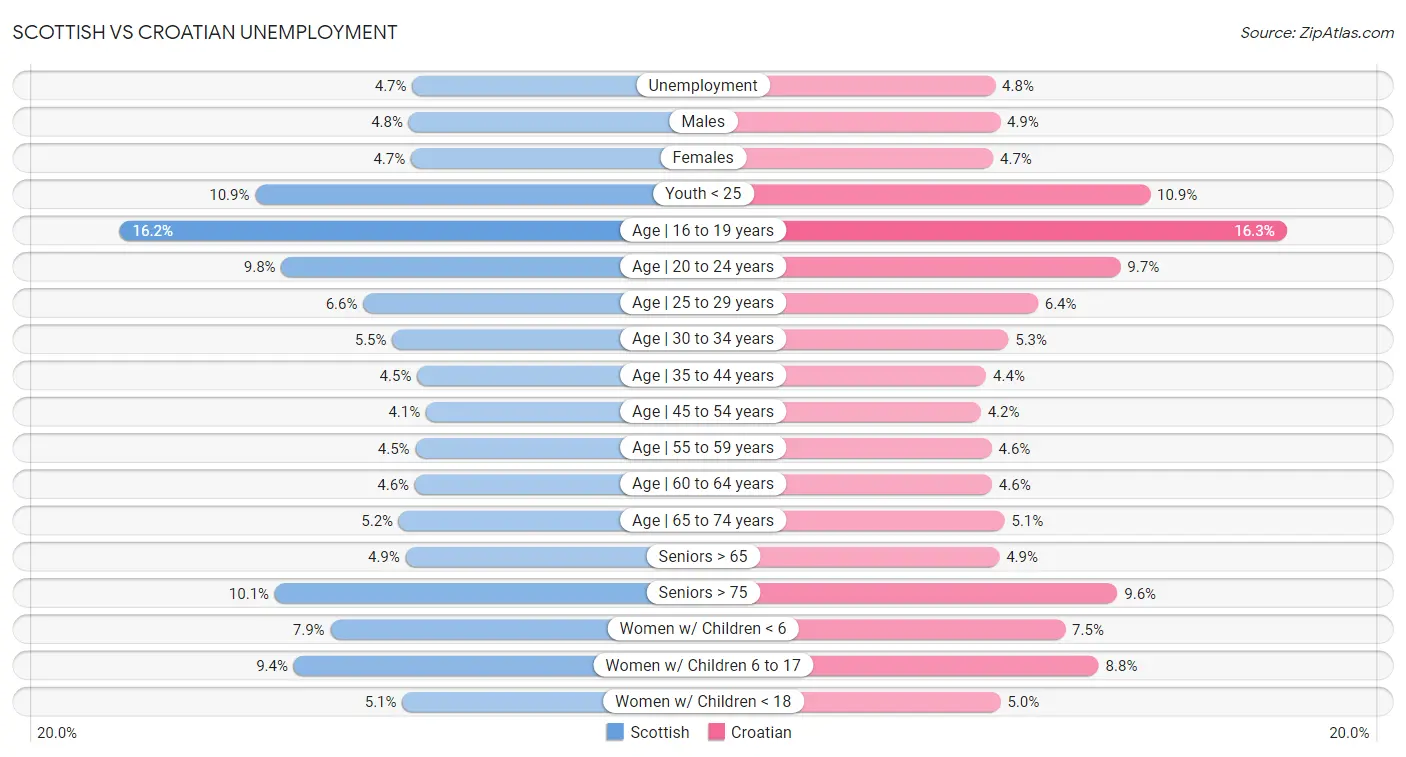
| Unemployment Metric | Scottish | Croatian |
| Unemployment | Exceptional 4.7% | Exceptional 4.8% |
| Males | Exceptional 4.8% | Exceptional 4.9% |
| Females | Exceptional 4.7% | Exceptional 4.7% |
| Youth < 25 | Exceptional 10.9% | Exceptional 10.9% |
| Age | 16 to 19 years | Exceptional 16.2% | Exceptional 16.3% |
| Age | 20 to 24 years | Exceptional 9.8% | Exceptional 9.7% |
| Age | 25 to 29 years | Good 6.6% | Excellent 6.4% |
| Age | 30 to 34 years | Average 5.5% | Excellent 5.3% |
| Age | 35 to 44 years | Exceptional 4.5% | Exceptional 4.4% |
| Age | 45 to 54 years | Exceptional 4.1% | Exceptional 4.2% |
| Age | 55 to 59 years | Exceptional 4.5% | Exceptional 4.6% |
| Age | 60 to 64 years | Exceptional 4.6% | Exceptional 4.6% |
| Age | 65 to 74 years | Exceptional 5.2% | Exceptional 5.1% |
| Seniors > 65 | Exceptional 4.9% | Exceptional 4.9% |
| Seniors > 75 | Tragic 10.1% | Tragic 9.6% |
| Women w/ Children < 6 | Poor 7.9% | Good 7.5% |
| Women w/ Children 6 to 17 | Tragic 9.4% | Good 8.8% |
| Women w/ Children < 18 | Exceptional 5.1% | Exceptional 5.0% |
Scottish vs Croatian Labor Participation
When considering labor participation, the most significant differences between Scottish and Croatian communities in the United States are seen in in labor force | age 16-19 (42.0% compared to 41.1%, a difference of 2.1%), in labor force | age 30-34 (84.2% compared to 85.6%, a difference of 1.7%), and in labor force | age 45-54 (82.2% compared to 83.6%, a difference of 1.7%). Conversely, both communities are more comparable in terms of in labor force | age 20-24 (77.4% compared to 77.2%, a difference of 0.23%), in labor force | age > 16 (63.9% compared to 64.7%, a difference of 1.3%), and in labor force | age 25-29 (84.6% compared to 85.8%, a difference of 1.4%).

| Labor Participation Metric | Scottish | Croatian |
| In Labor Force | Age > 16 | Tragic 63.9% | Tragic 64.7% |
| In Labor Force | Age 20-64 | Tragic 78.9% | Exceptional 80.1% |
| In Labor Force | Age 16-19 | Exceptional 42.0% | Exceptional 41.1% |
| In Labor Force | Age 20-24 | Exceptional 77.4% | Exceptional 77.2% |
| In Labor Force | Age 25-29 | Average 84.6% | Exceptional 85.8% |
| In Labor Force | Age 30-34 | Tragic 84.2% | Exceptional 85.6% |
| In Labor Force | Age 35-44 | Tragic 83.9% | Exceptional 85.2% |
| In Labor Force | Age 45-54 | Tragic 82.2% | Exceptional 83.6% |
Scottish vs Croatian Family Structure
When considering family structure, the most significant differences between Scottish and Croatian communities in the United States are seen in single father households (2.3% compared to 2.1%, a difference of 8.1%), divorced or separated (12.6% compared to 11.9%, a difference of 6.0%), and single mother households (5.8% compared to 5.5%, a difference of 5.5%). Conversely, both communities are more comparable in terms of average family size (3.11 compared to 3.10, a difference of 0.21%), currently married (49.2% compared to 48.9%, a difference of 0.65%), and married-couple households (49.0% compared to 48.5%, a difference of 1.0%).

| Family Structure Metric | Scottish | Croatian |
| Family Households | Good 64.5% | Tragic 63.8% |
| Family Households with Children | Tragic 27.0% | Tragic 26.4% |
| Married-couple Households | Exceptional 49.0% | Exceptional 48.5% |
| Average Family Size | Tragic 3.11 | Tragic 3.10 |
| Single Father Households | Good 2.3% | Exceptional 2.1% |
| Single Mother Households | Exceptional 5.8% | Exceptional 5.5% |
| Currently Married | Exceptional 49.2% | Exceptional 48.9% |
| Divorced or Separated | Tragic 12.6% | Excellent 11.9% |
| Births to Unmarried Women | Average 31.7% | Excellent 30.2% |
Scottish vs Croatian Vehicle Availability
When considering vehicle availability, the most significant differences between Scottish and Croatian communities in the United States are seen in no vehicles in household (6.8% compared to 8.3%, a difference of 22.1%), 4 or more vehicles in household (7.4% compared to 6.5%, a difference of 14.1%), and 3 or more vehicles in household (22.6% compared to 20.6%, a difference of 9.9%). Conversely, both communities are more comparable in terms of 1 or more vehicles in household (93.4% compared to 91.9%, a difference of 1.7%), 2 or more vehicles in household (61.2% compared to 58.6%, a difference of 4.5%), and 3 or more vehicles in household (22.6% compared to 20.6%, a difference of 9.9%).

| Vehicle Availability Metric | Scottish | Croatian |
| No Vehicles Available | Exceptional 6.8% | Exceptional 8.3% |
| 1+ Vehicles Available | Exceptional 93.4% | Exceptional 91.9% |
| 2+ Vehicles Available | Exceptional 61.2% | Exceptional 58.6% |
| 3+ Vehicles Available | Exceptional 22.6% | Exceptional 20.6% |
| 4+ Vehicles Available | Exceptional 7.4% | Good 6.5% |
Scottish vs Croatian Education Level
When considering education level, the most significant differences between Scottish and Croatian communities in the United States are seen in master's degree (15.2% compared to 16.4%, a difference of 8.0%), professional degree (4.6% compared to 4.9%, a difference of 7.9%), and bachelor's degree (38.1% compared to 40.6%, a difference of 6.8%). Conversely, both communities are more comparable in terms of 9th grade (96.5% compared to 96.5%, a difference of 0.0%), nursery school (98.7% compared to 98.6%, a difference of 0.060%), and kindergarten (98.6% compared to 98.6%, a difference of 0.060%).
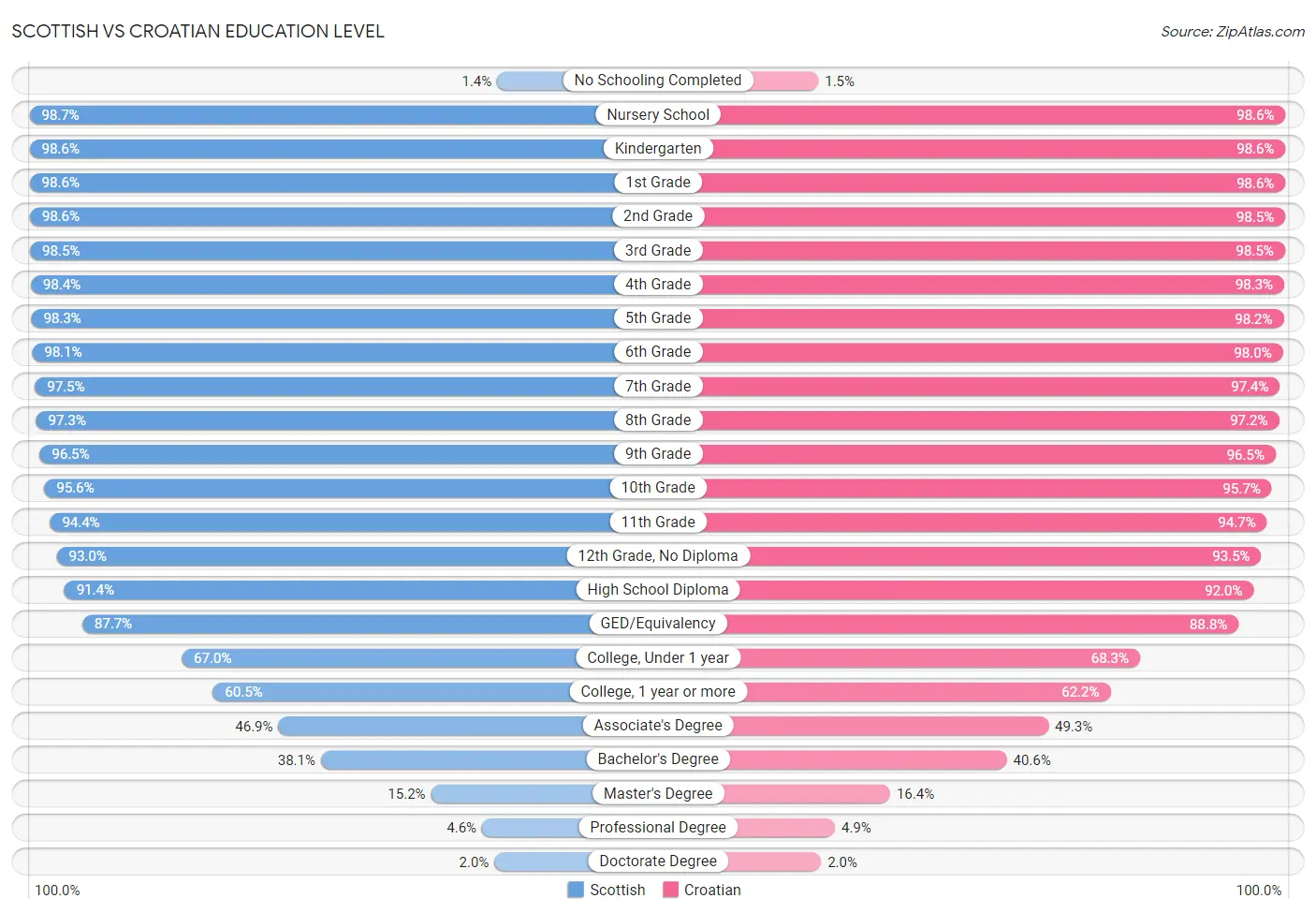
| Education Level Metric | Scottish | Croatian |
| No Schooling Completed | Exceptional 1.4% | Exceptional 1.5% |
| Nursery School | Exceptional 98.7% | Exceptional 98.6% |
| Kindergarten | Exceptional 98.6% | Exceptional 98.6% |
| 1st Grade | Exceptional 98.6% | Exceptional 98.6% |
| 2nd Grade | Exceptional 98.6% | Exceptional 98.5% |
| 3rd Grade | Exceptional 98.5% | Exceptional 98.5% |
| 4th Grade | Exceptional 98.4% | Exceptional 98.3% |
| 5th Grade | Exceptional 98.3% | Exceptional 98.2% |
| 6th Grade | Exceptional 98.1% | Exceptional 98.0% |
| 7th Grade | Exceptional 97.5% | Exceptional 97.4% |
| 8th Grade | Exceptional 97.3% | Exceptional 97.2% |
| 9th Grade | Exceptional 96.5% | Exceptional 96.5% |
| 10th Grade | Exceptional 95.6% | Exceptional 95.7% |
| 11th Grade | Exceptional 94.4% | Exceptional 94.7% |
| 12th Grade, No Diploma | Exceptional 93.0% | Exceptional 93.5% |
| High School Diploma | Exceptional 91.4% | Exceptional 92.0% |
| GED/Equivalency | Exceptional 87.7% | Exceptional 88.8% |
| College, Under 1 year | Exceptional 67.0% | Exceptional 68.3% |
| College, 1 year or more | Excellent 60.5% | Exceptional 62.2% |
| Associate's Degree | Good 46.9% | Exceptional 49.3% |
| Bachelor's Degree | Average 38.1% | Exceptional 40.6% |
| Master's Degree | Good 15.2% | Exceptional 16.4% |
| Professional Degree | Good 4.6% | Exceptional 4.9% |
| Doctorate Degree | Excellent 2.0% | Exceptional 2.0% |
Scottish vs Croatian Disability
When considering disability, the most significant differences between Scottish and Croatian communities in the United States are seen in disability age 35 to 64 (12.4% compared to 11.0%, a difference of 12.0%), vision disability (2.3% compared to 2.1%, a difference of 10.9%), and hearing disability (3.7% compared to 3.4%, a difference of 10.1%). Conversely, both communities are more comparable in terms of disability age over 75 (46.7% compared to 45.7%, a difference of 2.3%), cognitive disability (16.9% compared to 16.4%, a difference of 3.4%), and self-care disability (2.5% compared to 2.4%, a difference of 3.4%).
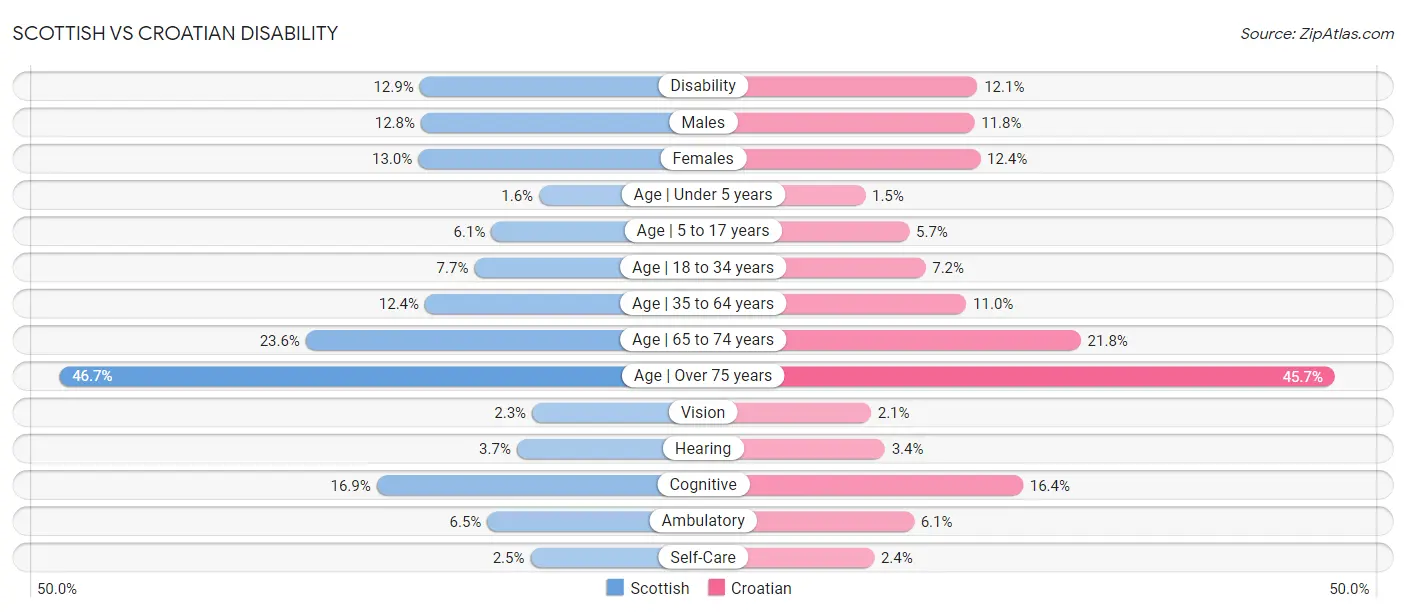
| Disability Metric | Scottish | Croatian |
| Disability | Tragic 12.9% | Tragic 12.1% |
| Males | Tragic 12.8% | Tragic 11.8% |
| Females | Tragic 13.0% | Fair 12.4% |
| Age | Under 5 years | Tragic 1.6% | Tragic 1.5% |
| Age | 5 to 17 years | Tragic 6.1% | Fair 5.7% |
| Age | 18 to 34 years | Tragic 7.7% | Tragic 7.2% |
| Age | 35 to 64 years | Tragic 12.4% | Good 11.0% |
| Age | 65 to 74 years | Fair 23.6% | Exceptional 21.8% |
| Age | Over 75 years | Exceptional 46.7% | Exceptional 45.7% |
| Vision | Tragic 2.3% | Exceptional 2.1% |
| Hearing | Tragic 3.7% | Tragic 3.4% |
| Cognitive | Exceptional 16.9% | Exceptional 16.4% |
| Ambulatory | Tragic 6.5% | Average 6.1% |
| Self-Care | Average 2.5% | Exceptional 2.4% |